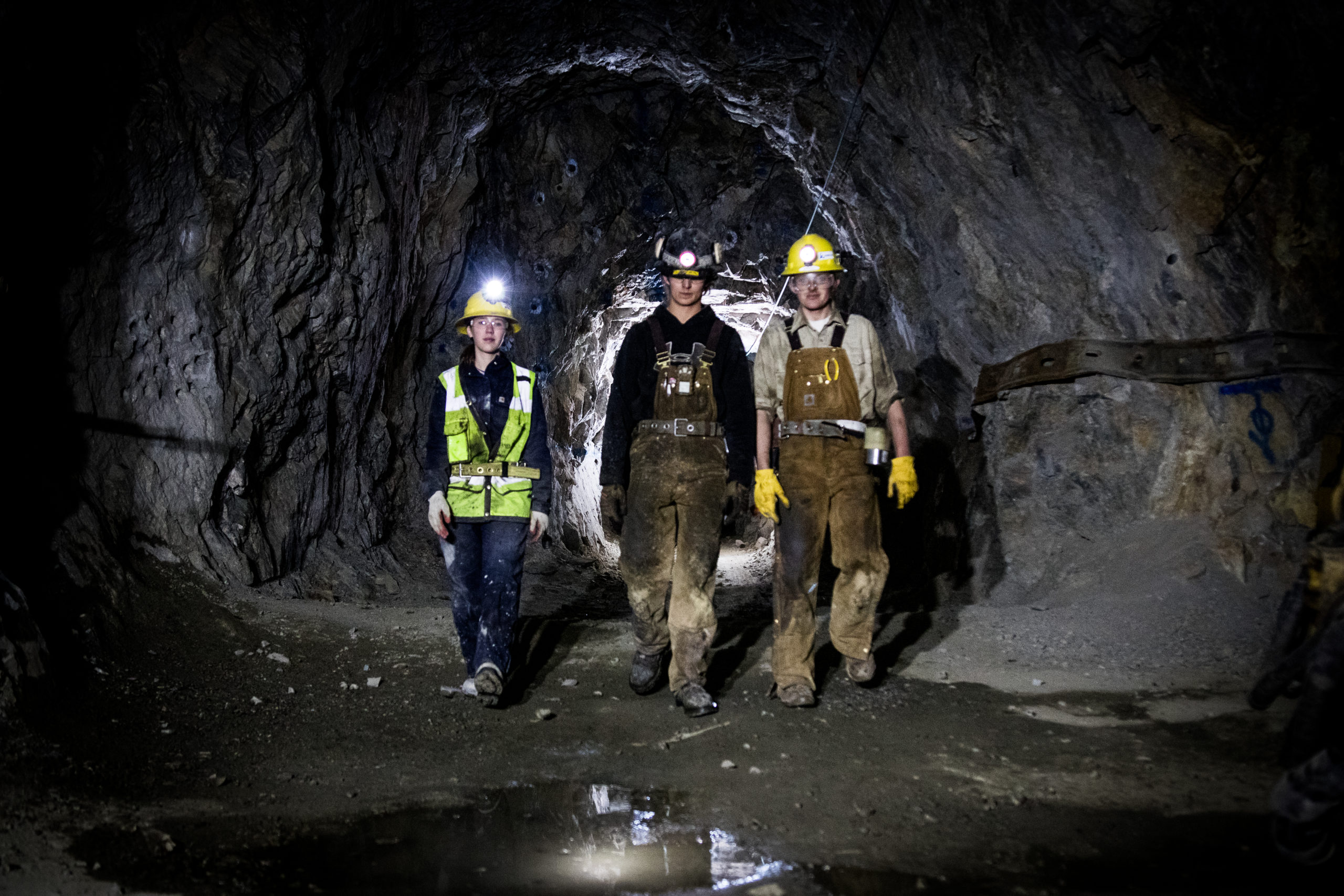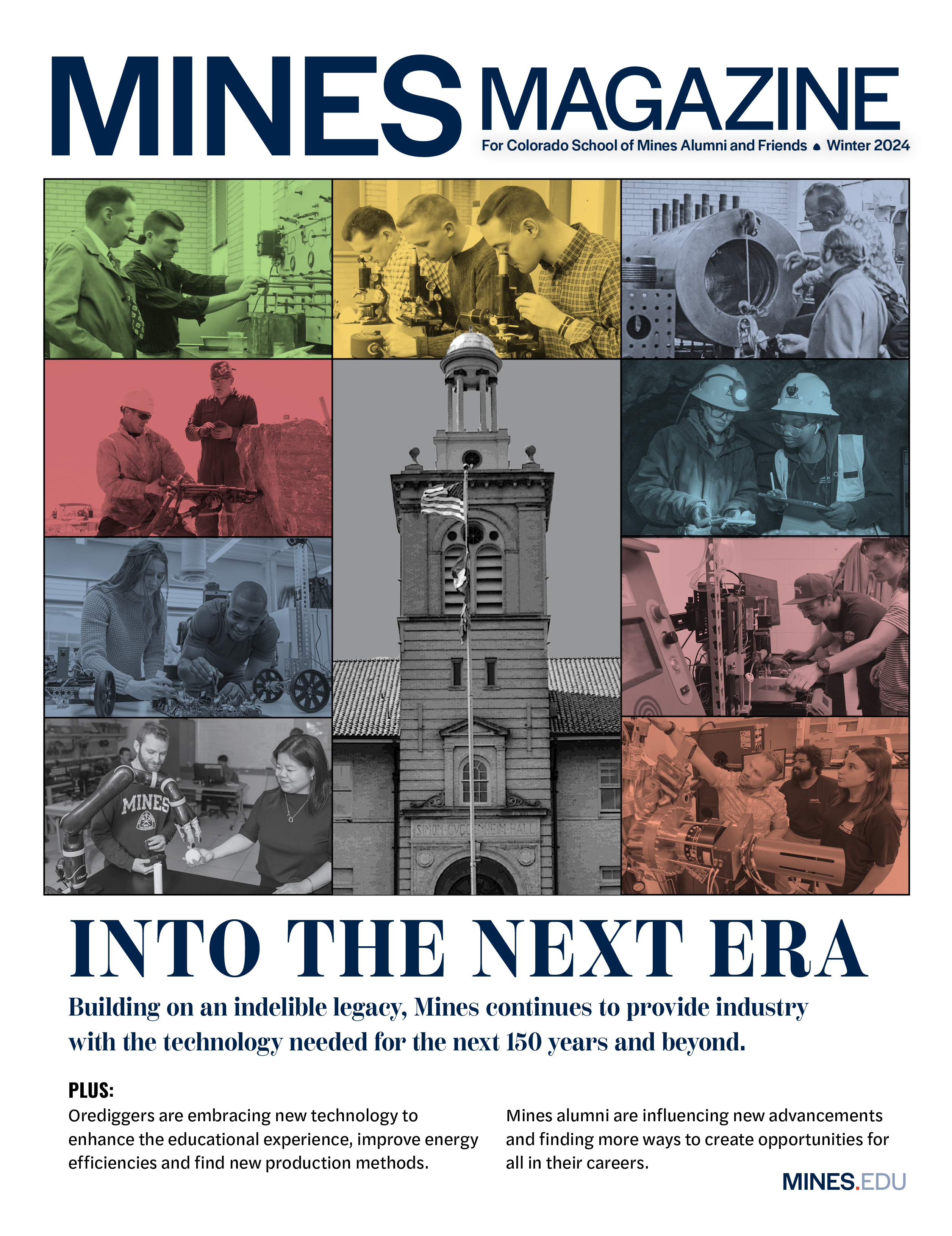The future is (still) underground

For 10 years, mining consultant Amy Jacobsen ’89 lived on a sailboat. Wind and solar energy powered her living quarters, but she had a backup gas generator for when the batteries drained. “That’s kind of the idea of how base power works when we mix it with renewables,” she said. “It’s got to be a mix, there’s no way around it.”
In this lower-carbon arrangement, all three power sources were essential. And all three require mined earth resources.
That slice of personal history mirrors a future envisioned in a report McKinsey & Company released in January 2020 that outlines what many in the mining industry already know: Though carbon is in decline, coal still accounts for half the global mining market. Meanwhile, renewables—and the earth resources they require—present a promising future for the mining industry.
From copper for wiring to lithium for electric-vehicle batteries to concrete for construction, mined materials are essential in modern life. “With our population growth, even if we became incredibly efficient, the demand would probably still exist for most materials we’re mining,” said Priscilla Nelson, professor of mining engineering.
And as the energy market shifts away from coal and toward renewables, the global demand for the earth resources they require is only expected to grow.
“The energy landscape globally is changing dramatically,” said Morgan Bazilian, director of the Payne Institute for Public Policy. “It appears almost certain that there’s going to be significantly more technologies like batteries, electric vehicles, photovoltaics and wind turbines deployed. All of those are mineral-intensive. Thus, the future energy system will be more mineral-intensive than the past.
“And the mining industry is starting to understand and be supportive of the clean energy transition, because they’ll play a fundamental role in it.”
Jacobsen, who runs Windward Consulting and is a senior associate at mineral industry advising firm Behre Dolbear, said miners are doing what they’ve always done: refocusing as demand changes. “There’s been a shift in what minerals are important. But that’s not unusual,” she said. “Over time, something disruptive comes along, and what minerals we need changes. Right now, the huge push for lithium, cobalt, copper and rare earth minerals—those are the big hot topics right now, and in the consulting world, everyone’s out there trying to find lithium.”
The industry regards the changes at hand as much more than just a trend, said Jacobsen, who is the president of the Mining and Metallurgical Society of America, which plans to launch a series of webinars on this topic in the fall. “The industry will continue to adapt to the changes in our society—how we generate and distribute energy, how we preserve the environment and how we do all this safely and economically.”
Critical materials
Renewables, which accounted for 17 percent of energy generation in the U.S. in 2018, come with a heavy demand for metals.
Large amounts of aluminum and copper go into wind turbines. Storing the energy generated by wind and solar requires materials the U.S. has deemed critical to economic and national security, such as lithium and cobalt. The high-efficiency motors that wind turbines and electric cars use require rare earth elements such as dysprosium and neodymium for permanent magnets. The federal government considers rare earths so critical to national security that the U.S. Army is now funding commercial-scale rare earths processing facilities. Another rare metal, tellurium, is used in a film in photovoltaic solar cells to make them more efficient—the U.S. Geologic Survey calls it one of the least-common elements on the planet.
“From a mining standpoint, it’s a huge opportunity,” said Timothy Haddon ’70, president and CEO of International Natural Resources Management. “We’ve got the various heavy metals—or rare earths—the requirements of those are going to go up significantly. We’re currently getting the supply from China, and we need to diversify the source for practical reasons.”
But it’s an opportunity that comes with a few challenges, one of which is that many of the known deposits of these minerals are in places where it’s difficult to mine. “I’ve heard this many times and I actually agree: All the easy deposits have been mined,” Jacobsen said.
Just one of these metals provides a case study for the challenges ahead. “Cobalt is a real issue,” Jacobsen said. Cobalt is a crucial component of rechargeable lithium-ion batteries and the permanent magnets that give wind turbines their efficiency. “The biggest deposits occur in the Democratic Republic of Congo—a challenging place to work, a challenging place, as a company, to go in and try to build a mine.”
Meanwhile, researchers at Mines are tackling the question of how to meet the demand for critical materials from many angles, from policy to production.
“There will certainly be increased demand for these materials, and the question is, how well positioned is the world economy to satisfy this increased demand?” said Rod Eggert, Viola Vestal Coulter Chair in Mineral Economics and deputy director of the U.S. Department of Energy’s Critical Materials Institute.
Mining more could help meet the demand, but recycling and reducing waste in mining processes will help as well. For example, researchers in the Metallurgical and Materials Engineering and Mining Engineering departments are working on ways to separate rare earths from other materials more efficiently. “There are 15 or so rare earth elements that tend to be found together in nature, and historically, that separation has been really inefficient,” Eggert said. “So there’s room for dramatic improvement.”
The mining industry will need to make other advancements in extraction and exploration as well, and a project at Mines that won National Science Foundation funding last year promises to bring more efficiency to both through artificial intelligence and data analytics.
“In comparison to oil and gas, the geology of metal deposits is very complicated, and metal deposits that can be mined economically are difficult to find,” said Thomas Monecke, associate professor of geology and geological engineering.
Monecke is the site director for the Center for Advanced Subsurface Earth Resource Models, a research collaboration between Mines and Virginia Tech that brings geologists and mathematicians together to work on subsurface modeling techniques to make mining more precise and efficient, from exploration to development. “Ultimately, big data is going to be transformational in mining,” Monecke said. “If you think about other industries, like the car industry or airplanes, they don’t build models anymore—it’s all computational.”
Adapting technology to meet new demands
The McKinsey report also outlined industry risks related to climate change (primarily water stress and how increased temperatures will affect the workforce), as well as how the mining industry can decarbonize itself.
The industry is already adopting innovations to keep workers safer and reduce its own carbon footprint.
“Through my career I’ve watched different innovations come in, and sometimes I’m astounded,” Jacobsen said. She recalled visiting Kennecott’s Bingham copper pit, outside Salt Lake City, in the 1990s. The mine’s trucks were using a relatively brand-new technology. “They had implemented GPS on the trucks and the shovels so if a shovel broke down, they could send a truck to a shovel that was working. It was how they could efficiently keep the pit running—because every time you fire up one of those trucks and move it, it costs money.”
“GPS was little heard of at the time, so I was like, wow!” she said. “A decade later, it’s an everyday term. Mining’s always ahead of the curve.” Now, she said, drones are active at mining sites, keeping people away from dangerous situations, and the industry is switching from diesel to electric vehicles.
“We’re always trying to be the lowest-cost and most profitable miners,” Haddon said. “So we’re instituting things like blockchain, drones, AI, remote mining. Most people think of mining as a stodgy, slow-to-change industry, and that’s not the truth.”
He cited Rio Tinto’s remote-operated trucks, shovels and drills in Western Australia. “You’ve got people sitting in Perth, 1,000 miles south of the mines, remotely operating this equipment so they don’t have to pay for the remote living expenses, and they have a better quality of life living in the cities,” he said.
It’s another sign that beyond the shifting demand for critical materials, the industry itself is changing, Nelson said. “I think the mining industry is going to go increasingly toward the use of renewables. It’s going to go away from the use of diesel, it’s going to go toward the increasing use of electric vehicles underground, the use of robotics, and, I hope, the use of selective mining.”
All of these changes present a unique opportunity for students. “In the mining industry itself, a lot of senior people are getting ready to retire, and there aren’t enough people to come up in the ranks,” Nelson said. “We’re getting into mines that are going deeper and deeper, and we don’t want to put people there, so we need more robotics. In mineral processing, we need more people in chemical engineering.” And with big data promising to transform the industry, she said, “We need people who understand how to write Python code.”
Current Mines students see all of these changes as a positive for their careers. Martina Gilbert, a junior in mining engineering, president of Mines’ Women in Mining chapter and chief technician for the Mine Rescue Team, said she sees a bright future ahead. “Mining is what makes America possible,” she said. “The increasing number of minerals needed to produce every laptop, every cell phone, every home—the demand is just going to grow.”


